Garrick Brazil
DEVIANT: Depth EquiVarIAnt NeTwork for Monocular 3D Object Detection
Jul 21, 2022
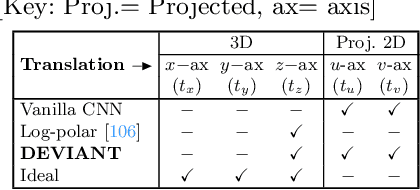

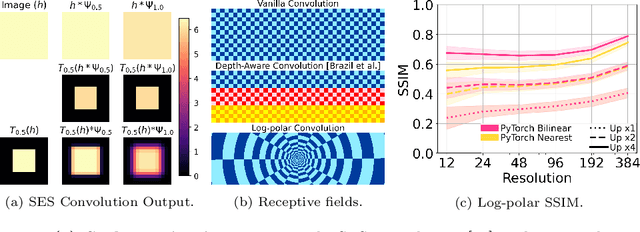
Abstract:Modern neural networks use building blocks such as convolutions that are equivariant to arbitrary 2D translations. However, these vanilla blocks are not equivariant to arbitrary 3D translations in the projective manifold. Even then, all monocular 3D detectors use vanilla blocks to obtain the 3D coordinates, a task for which the vanilla blocks are not designed for. This paper takes the first step towards convolutions equivariant to arbitrary 3D translations in the projective manifold. Since the depth is the hardest to estimate for monocular detection, this paper proposes Depth EquiVarIAnt NeTwork (DEVIANT) built with existing scale equivariant steerable blocks. As a result, DEVIANT is equivariant to the depth translations in the projective manifold whereas vanilla networks are not. The additional depth equivariance forces the DEVIANT to learn consistent depth estimates, and therefore, DEVIANT achieves state-of-the-art monocular 3D detection results on KITTI and Waymo datasets in the image-only category and performs competitively to methods using extra information. Moreover, DEVIANT works better than vanilla networks in cross-dataset evaluation. Code and models at https://github.com/abhi1kumar/DEVIANT
Omni3D: A Large Benchmark and Model for 3D Object Detection in the Wild
Jul 21, 2022
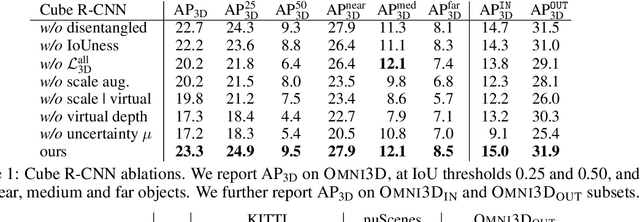

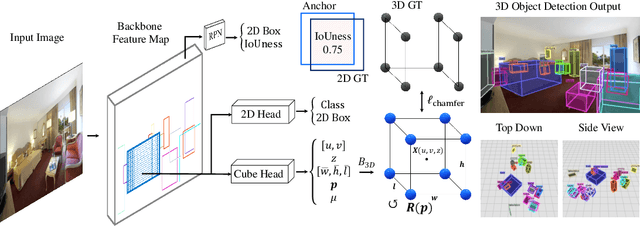
Abstract:Recognizing scenes and objects in 3D from a single image is a longstanding goal of computer vision with applications in robotics and AR/VR. For 2D recognition, large datasets and scalable solutions have led to unprecedented advances. In 3D, existing benchmarks are small in size and approaches specialize in few object categories and specific domains, e.g. urban driving scenes. Motivated by the success of 2D recognition, we revisit the task of 3D object detection by introducing a large benchmark, called Omni3D. Omni3D re-purposes and combines existing datasets resulting in 234k images annotated with more than 3 million instances and 97 categories.3D detection at such scale is challenging due to variations in camera intrinsics and the rich diversity of scene and object types. We propose a model, called Cube R-CNN, designed to generalize across camera and scene types with a unified approach. We show that Cube R-CNN outperforms prior works on the larger Omni3D and existing benchmarks. Finally, we prove that Omni3D is a powerful dataset for 3D object recognition, show that it improves single-dataset performance and can accelerate learning on new smaller datasets via pre-training.
GrooMeD-NMS: Grouped Mathematically Differentiable NMS for Monocular 3D Object Detection
Mar 31, 2021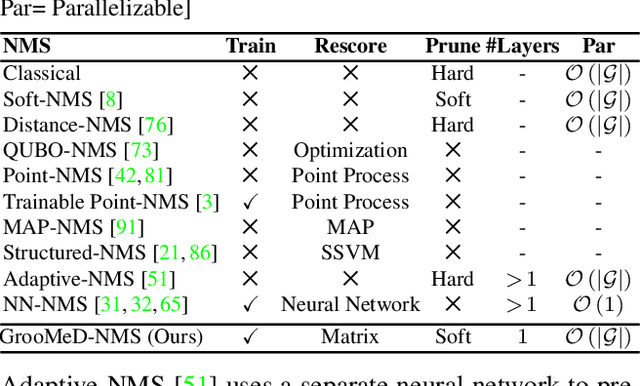
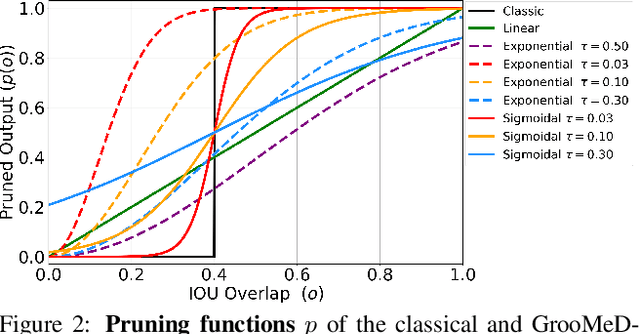
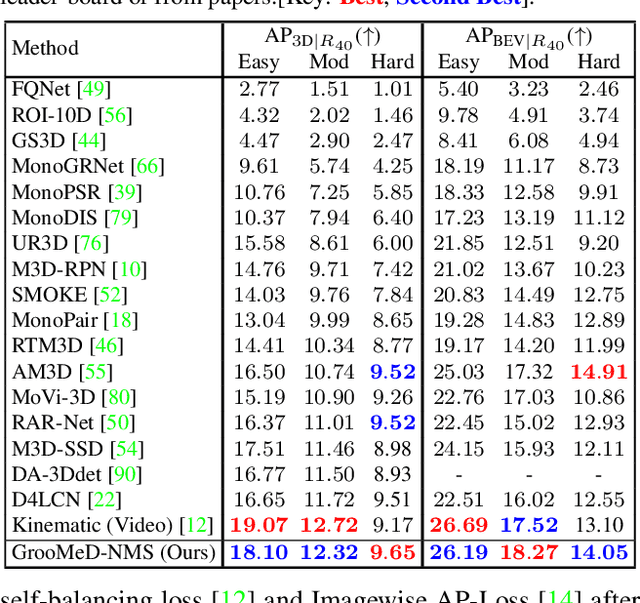

Abstract:Modern 3D object detectors have immensely benefited from the end-to-end learning idea. However, most of them use a post-processing algorithm called Non-Maximal Suppression (NMS) only during inference. While there were attempts to include NMS in the training pipeline for tasks such as 2D object detection, they have been less widely adopted due to a non-mathematical expression of the NMS. In this paper, we present and integrate GrooMeD-NMS -- a novel Grouped Mathematically Differentiable NMS for monocular 3D object detection, such that the network is trained end-to-end with a loss on the boxes after NMS. We first formulate NMS as a matrix operation and then group and mask the boxes in an unsupervised manner to obtain a simple closed-form expression of the NMS. GrooMeD-NMS addresses the mismatch between training and inference pipelines and, therefore, forces the network to select the best 3D box in a differentiable manner. As a result, GrooMeD-NMS achieves state-of-the-art monocular 3D object detection results on the KITTI benchmark dataset performing comparably to monocular video-based methods. Code and models at https://github.com/abhi1kumar/groomed_nms
Kinematic 3D Object Detection in Monocular Video
Jul 19, 2020


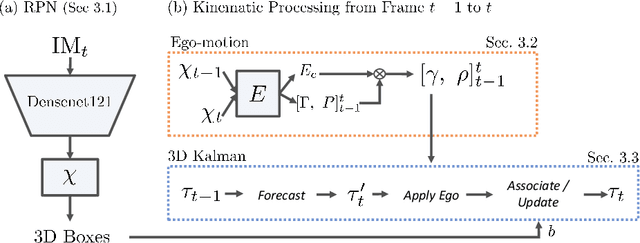
Abstract:Perceiving the physical world in 3D is fundamental for self-driving applications. Although temporal motion is an invaluable resource to human vision for detection, tracking, and depth perception, such features have not been thoroughly utilized in modern 3D object detectors. In this work, we propose a novel method for monocular video-based 3D object detection which carefully leverages kinematic motion to improve precision of 3D localization. Specifically, we first propose a novel decomposition of object orientation as well as a self-balancing 3D confidence. We show that both components are critical to enable our kinematic model to work effectively. Collectively, using only a single model, we efficiently leverage 3D kinematics from monocular videos to improve the overall localization precision in 3D object detection while also producing useful by-products of scene dynamics (ego-motion and per-object velocity). We achieve state-of-the-art performance on monocular 3D object detection and the Bird's Eye View tasks within the KITTI self-driving dataset.
The Edge of Depth: Explicit Constraints between Segmentation and Depth
Apr 01, 2020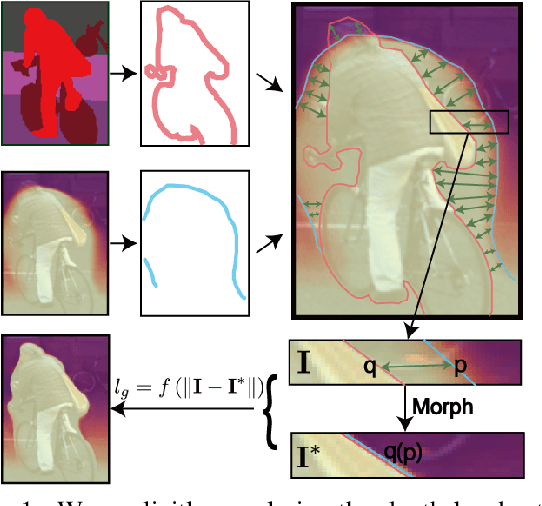
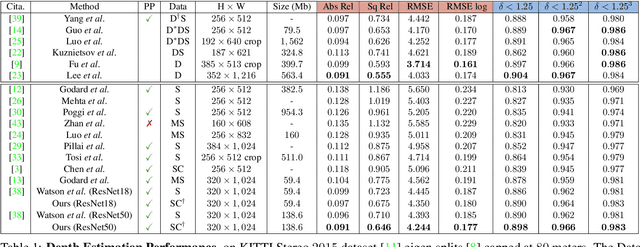
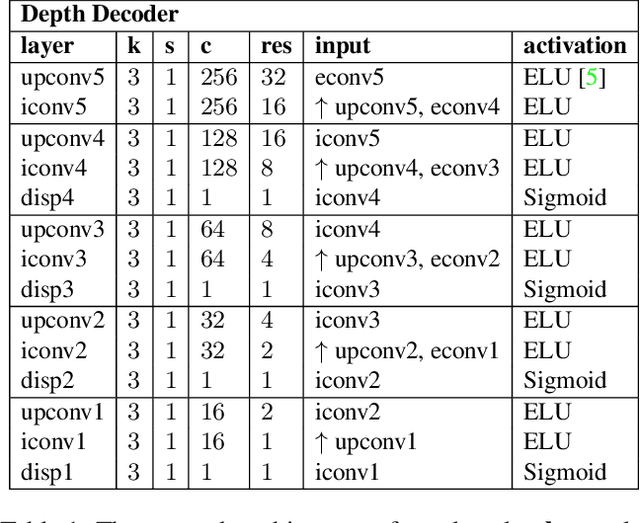
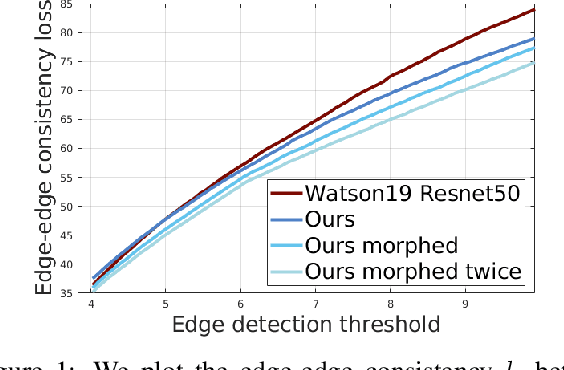
Abstract:In this work we study the mutual benefits of two common computer vision tasks, self-supervised depth estimation and semantic segmentation from images. For example, to help unsupervised monocular depth estimation, constraints from semantic segmentation has been explored implicitly such as sharing and transforming features. In contrast, we propose to explicitly measure the border consistency between segmentation and depth and minimize it in a greedy manner by iteratively supervising the network towards a locally optimal solution. Partially this is motivated by our observation that semantic segmentation even trained with limited ground truth (200 images of KITTI) can offer more accurate border than that of any (monocular or stereo) image-based depth estimation. Through extensive experiments, our proposed approach advances the state of the art on unsupervised monocular depth estimation in the KITTI.
M3D-RPN: Monocular 3D Region Proposal Network for Object Detection
Aug 11, 2019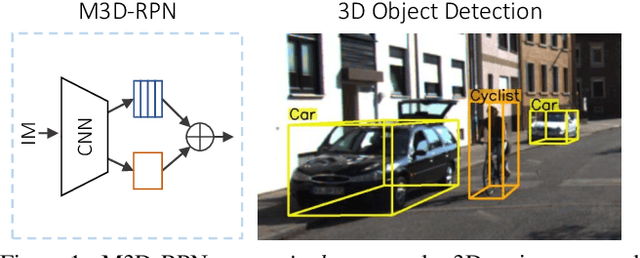

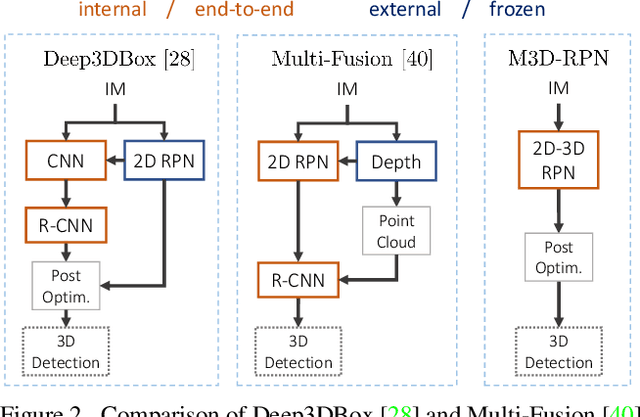

Abstract:Understanding the world in 3D is a critical component of urban autonomous driving. Generally, the combination of expensive LiDAR sensors and stereo RGB imaging has been paramount for successful 3D object detection algorithms, whereas monocular image-only methods experience drastically reduced performance. We propose to reduce the gap by reformulating the monocular 3D detection problem as a standalone 3D region proposal network. We leverage the geometric relationship of 2D and 3D perspectives, allowing 3D boxes to utilize well-known and powerful convolutional features generated in the image-space. To help address the strenuous 3D parameter estimations, we further design depth-aware convolutional layers which enable location specific feature development and in consequence improved 3D scene understanding. Compared to prior work in monocular 3D detection, our method consists of only the proposed 3D region proposal network rather than relying on external networks, data, or multiple stages. M3D-RPN is able to significantly improve the performance of both monocular 3D Object Detection and Bird's Eye View tasks within the KITTI urban autonomous driving dataset, while efficiently using a shared multi-class model.
Pedestrian Detection with Autoregressive Network Phases
Dec 02, 2018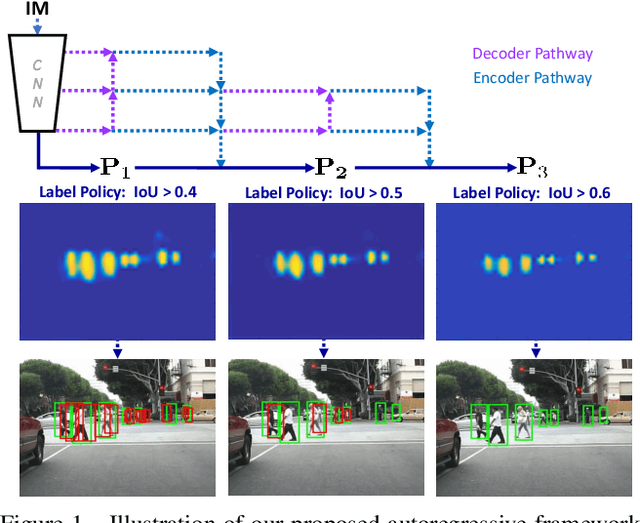


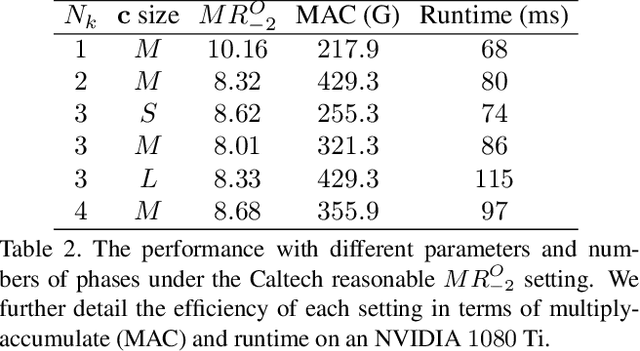
Abstract:We present an autoregressive pedestrian detection framework with cascaded phases designed to progressively improve precision. The proposed framework utilizes a novel lightweight stackable decoder-encoder module which uses convolutional re-sampling layers to improve features while maintaining efficient memory and runtime cost. Unlike previous cascaded detection systems, our proposed framework is designed within a region proposal network and thus retains greater context of nearby detections compared to independently processed RoI systems. We explicitly encourage increasing levels of precision by assigning strict labeling policies to each consecutive phase such that early phases develop features primarily focused on achieving high recall and later on accurate precision. In consequence, the final feature maps form more peaky radial gradients emulating from the centroids of unique pedestrians. Using our proposed autoregressive framework leads to new state-of-the-art performance on the reasonable and occlusion settings of the Caltech pedestrian dataset, and achieves competitive state-of-the-art performance on the KITTI dataset.
Recurrent Flow-Guided Semantic Forecasting
Sep 21, 2018

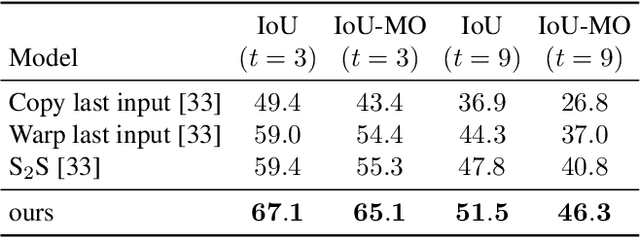

Abstract:Understanding the world around us and making decisions about the future is a critical component to human intelligence. As autonomous systems continue to develop, their ability to reason about the future will be the key to their success. Semantic anticipation is a relatively under-explored area for which autonomous vehicles could take advantage of (e.g., forecasting pedestrian trajectories). Motivated by the need for real-time prediction in autonomous systems, we propose to decompose the challenging semantic forecasting task into two subtasks: current frame segmentation and future optical flow prediction. Through this decomposition, we built an efficient, effective, low overhead model with three main components: flow prediction network, feature-flow aggregation LSTM, and end-to-end learnable warp layer. Our proposed method achieves state-of-the-art accuracy on short-term and moving objects semantic forecasting while simultaneously reducing model parameters by up to 95% and increasing efficiency by greater than 40x.
Illuminating Pedestrians via Simultaneous Detection & Segmentation
Jun 26, 2017

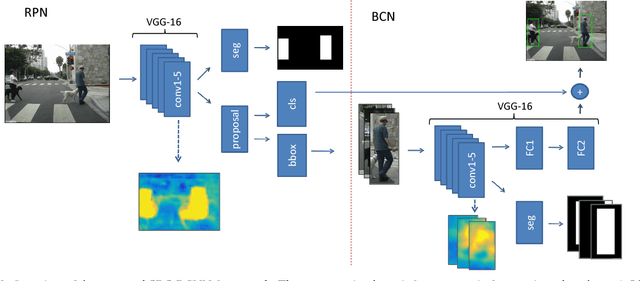

Abstract:Pedestrian detection is a critical problem in computer vision with significant impact on safety in urban autonomous driving. In this work, we explore how semantic segmentation can be used to boost pedestrian detection accuracy while having little to no impact on network efficiency. We propose a segmentation infusion network to enable joint supervision on semantic segmentation and pedestrian detection. When placed properly, the additional supervision helps guide features in shared layers to become more sophisticated and helpful for the downstream pedestrian detector. Using this approach, we find weakly annotated boxes to be sufficient for considerable performance gains. We provide an in-depth analysis to demonstrate how shared layers are shaped by the segmentation supervision. In doing so, we show that the resulting feature maps become more semantically meaningful and robust to shape and occlusion. Overall, our simultaneous detection and segmentation framework achieves a considerable gain over the state-of-the-art on the Caltech pedestrian dataset, competitive performance on KITTI, and executes 2x faster than competitive methods.
 Add to Chrome
Add to Chrome Add to Firefox
Add to Firefox Add to Edge
Add to Edge